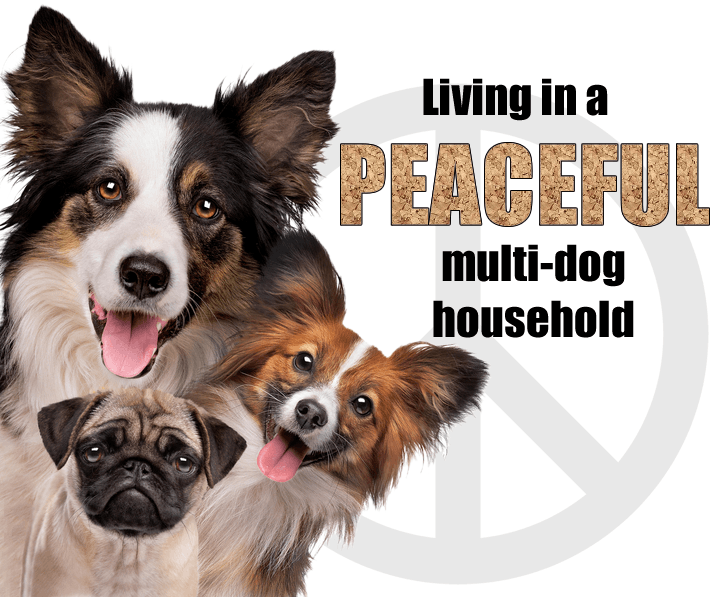A single dog in the home will act one way. 2 dogs in the home will change things a bit. 3 or more and you're dealing with a whole other set of dogdom rules - this is the point you'll really see a need for management in a multi-dog household!
The GOOD news is, a bit of foresight and a few key rules can make all the difference when trying to keep the peace. Whether you have 2 dogs or 20, there are some simple ways to ensure it stays wonderful when one is not enough.
What's Obedience Got to do With it?
It's fair to say that all dogs need basic education in obedience, just like all humans need some form of education. Obedience training allows us to offer our dogs freedom, knowing that we can keep them safe in a world that's foreign to their natural instincts and potentially full of dangers. Safety is number one, but next in the line of important reasons to teach obedience skills is the desire to enjoy your relationship with your 4-legged family member to its fullest. Life with a dog who has had some obedience training is a stark contrast to life with a dog who has not. This is especially true of dogs in multi-dog households.
One dog without obedience is a pain.....
Two dogs without obedience could be a nightmare!
Whether you do your own obedience training or seek the help of a professional, all dogs in the home should be responsive to verbal commands under stress and distraction. We influence our dog's worlds enough that they can't be expected to self-regulate. Despite their strength and sharp teeth, or likely because of it, if left to their own devices dogs are fairly risk-averse as a species. With stable dogs, fights are avoided unless there is a specific event or reason deemed worthy of the risk. Instinctually, dogs are aware that a fight outcome could be injury or even death. It's a negotiating tactic of last resort.
Without resorting to fights, dogs communicate fluidly with each other through subtle gestures and body language and peace prevails unless there is a definitive reason to break that deal.
Enter humans and life in close quarters.... these are factors that change it all.
Like it or not, it's not all going to be sunshine and roses - even if it is most of the time. Even dogs that get along 99% of the time can still be presented with conflict. Having enough relationship with each dog as an individual will allow you to know what you should be careful of and what might trigger conflict with the other dogs in the home. Being able to quickly stop escalating tension could mean everything.
3 Must have Obedience Tools for a Multi-Dog Household
Tool #1: Response to Name
Being able to get the attention of any dog in your home in an instant might mean the difference between a nice quiet afternoon and a trip to the Emergency Vet! This is the first tool you have for de-escalation.
Often, our students are surprised to hear that we take time to TEACH our dogs their names as well as the expectation when when they hear it. Take the time to create a dynamite response to name so you always have a way of quickly getting your dog's attention!
When should you use it? ANYTIME. If you see something that makes you feel uncomfortable, TRUST YOUR INSTINCT! If body language looks tense or play seems to be too rough, call your dog's name. Being able to quickly gain their focus is the best way to interrupt and take the steam out of the situation. Once they are focused on you, you can assess and guide each dog to other activities if necessary.
While that one event may not have erupted into a dog fight, the accumulation of hostile feelings will cause resentment in dogs in the form of habitualized behaviour. If the association they have with interacting with the other dog(s) in the home becomes one surrounded with resentment, fear or anxiety, the home becomes a tinderbox.
Tool #2: Settle
This command is one of my favourites!
I initially teach it as a game on/game off skill where we play and then end play, rewarding the dog for quickly calming. I then let this command bleed into everyday life. If they are excited about something and I want them to calm, I will say settle and the expectation is a quick drain of energy and quick calming of emotions. Having a pre-conditioned cue for this use is really helpful to prevent emotions from bubbling over when excitement occurs in a shared space. Think about the energy at the front door when a guest arrives, or excitement over mealtime or walking rituals. These are all times when the ability to quickly calm energy comes in really handy.
Tool #3: Go to your place
Sharing space can be stressful for dogs. Even if you have a massive home, there are still territorial feelings that will drive behaviour. Being able to send your dogs to their own space is a wonderful tool for managing tensions. This is especially true when there are perceived resources, like food, toys or guests. Being able to send your dog to their crate or bed on command is a really useful tool for keeping tensions from building.
Tool #4: Wait Your Turn
This is likely the most used cue in my household. "Wait" means hold your horses until I give you more information. It is very informal and often becomes an implied command. For example, as I prepare my dog's meals, they all know they won't get to eat until they're sitting calmly and attentively. I put bowls down and release dogs one at a time. This ritualized self-control forces them to focus on me and their impulses to get what they want, which prevents them from jumping over each other and chaotically trying to get their dinners.
Patience and self-control is a crucial component of dog training. Most dogs lack self-control and require extensive teaching of it to help them navigate our world. Teaching your dogs to wait for a release at doors, at their food bowls, from their crates and for their turn goes a long way in a multi-dog household. It cuts down on the competition factor and insists that all dogs in your home practise good impulse control.
Rules for Multi-Dog Households
A few consistent rules in the home will help to ensure everyone lives harmoniously. These tend to surround resources that might promote competition.
What are the things your dog loves? They will vary from household to household, breed to breed and even dog to dog. A dog will view resources differently based on their own unique likes. Some dogs will do backflips for food while others don't find it as valuable. The dog who LOVES food might be more willing to compete for it. The dog who is not overly motivated by food and is content in their never-gone-hungry, domesticated lives will likely not put up a fuss over food, but that same dog might be really inclined to compete for a toy.
Knowing your dog and what they love will go a long way towards the rules you create to manage your home. A few general rules I always enforce in my own multi-dog home:
Rule #1: You are never allowed to take an item from another dog
Dogdom rules dictate that dogs have the right to possess 'things'. As humans, we spend time working to convince our dogs that we're NOT a threat when they have something of value. We balance out this instinctual right with good training and build a communication strategy that allows us to safely remove items our dogs value.
Other dogs in the home will NOT build this balance, so it's up to us. If a dog leaves an item, it's fair game, but if they are actively engaged or chewing, other dogs need to leave that dog alone with their prize. A quick response to name when Spot is eyeballing Fido's bone is an easy way to gain focus and then redirection can occur.
If it's a toy, the dog who possesses the toy is the only one who can try to initiate play. If they want to be left alone with their toy, allowing them that privilege is the right thing to do.
Rule #2: No competing with each other for resources
Resources is a very broad term. They include anything the dog values (food, toys, humans, spaces of status/comfort, safety, sex..... and so on).
Competition can fuel feelings of anxiety and frustration and can accumulate quickly. Once dogs get into the habit of competing, it's hard to go backwards from them and is akin to trying to put the toothpaste back into the tube. Ensure that your dogs are not set up to feel the need to compete with each other.
Multi-dog households should either have enough for all or none. For example, if you have 3 dogs who all love their Kongs, leaving one Kong laying around might bring on competition. If one dog is given a chew. If play is overly hostile. If barging through spaces is allowed. If affection is given unevenly or demanded. Anything that rehearses competing could start to cause problems and is best headed off at the pass!
A few rules and a bit of guidance and a peaceful household will ensue!
Until next time,
Happy Training!

